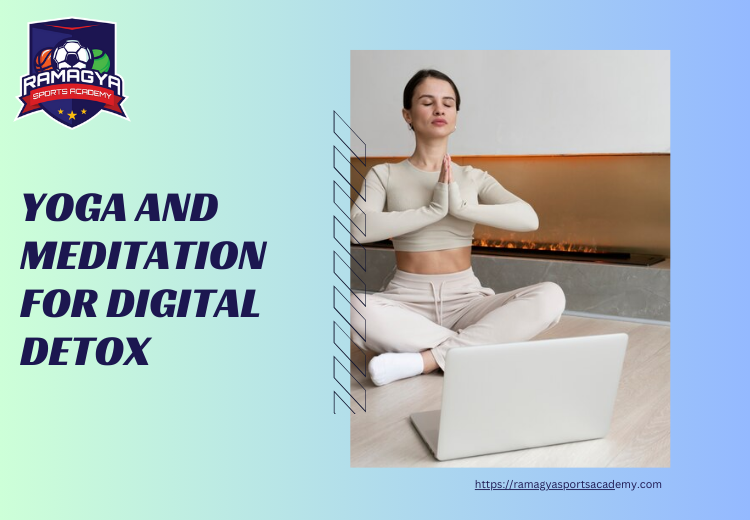
Proud Moment | Meenakshi Srinivasan Represents India at the 2024 ITF Masters 45+ World Team & Individual Championships
December 9, 2024
Building Confidence on Skates: Step-by-Step Guide
December 11, 2024Yoga and Meditation for Digital Detox

In the fast-paced world of today with screens dominating our daily lives, finding times of peace and focus can seem like an impossible possibility.There is little time for true introspection and relaxation since we are bombarded with emails, messages, and notifications all the time.
We also feel pressured to be up to date on social media. Our physical and mental health may suffer from a continuous internet connection, which can lead to stress, anxiety, and difficulty sleeping. But there are effective solutions to the digital abyss such as meditation and yoga. These ancient practices are the opportunity to get away from the digital whirlwind and reconnect with our inner being.
Let’s examine how yoga and meditation could aid in a detoxification process and restore harmony in our lives.
Understanding Digital Detox
Before tackling the solution, it’s essential to know the issue. Digital detox is the time when people are not using electronic devices, such as smartphones or computers. They also avoid tablets and laptops. The aim is to lessen stress and concentrate on real relationships and social activities.
The need to detoxify digitally is due to the excessive stimulation caused by continuous screen exposure. This can cause:
- Increased Stress: Constant exposure to messages and information can overburden our brains, resulting in chronic stress.
- Sleeping Problems: Blue light that is emitted by screens can disrupt the production of melatonin, making it difficult to fall asleep and impacting the quality of sleep.
- Lower productivity: Continuous multitasking and distractions can affect our ability to focus and finish tasks effectively.
The Role of Yoga and Meditation in Digital Detox
Yoga is much more than physical exercise. It’s an integrated practice that combines the mind, body, and breath. It is one of the best relaxation exercises. This is how yoga can help with digital detox:
- Relaxation from physical tension: Yoga postures (asanas) assist in the release of tension that builds up within the body as a result of the long periods of sitting or screen use.
- Improved flexibility and strength: Regular training increases flexibility and strengthens muscles that might be weak due to long sitting.
- Reduce Stress: Mindful movements through yoga, when combined with deep breathing, stimulates the parasympathetic nervous system helping to relax and reduce stress levels.
- Increased mindfulness: Yoga encourages present-moment awareness and teaches us to be aware of our thoughts and feelings without judgment.
- Improved mood: Certain yoga poses trigger endorphins. These are the body’s natural mood-enhancing hormones.
Establishing Routines:
Morning Yoga Routine: Beginning your day with a brief yoga practice sets a positive vibe and helps reduce the need to quickly check the devices.
Evening Relaxation: Yoga poses and relaxation techniques prepare your body and mind to get a restful sleep, while reducing the consequences of intensive screen-time.
Incorporating Meditation for Digital Detox
Meditation is a great complement to yoga, as it helps in quieting the mind and fostering inner peace. Here’s how meditation helps in the digital detox process:
- Mindfulness Meditation: Concentrating on meditation with mindfulness trains the mind to concentrate on the present moment, rather than thinking about the past or the future.
- Be aware of Digital Habits: By becoming more conscious, we will be able to discern bad digital habits, like excessive scrolling and decide to stop them.
- Breath Awareness: Breathing practices (pranayama) employed in meditation have a soothing effect on nervous systems, which helps in reducing anxiety and helping to promote relaxation.
- Stress Management: Learning breathing techniques that allow you to relax in stressful times can help you resist the temptation to turn to digital distractions to get some relief.
Practical Tips for a Successful Digital Detox
- Start small: Begin with brief meditation or yoga sessions then gradually increasing the time as you get more at ease.
- Designate tech-free zones: Make sacred areas within your home where electronic devices aren’t allowed in areas such as the dining room or bedroom.
- Unplug regularly: Set up regular periods of digital detox in your schedule, whether it’s for only a few hours per week or a full day every week to replenish and reconnect.
- Enjoy nature: Take time in nature, participating with activities such as hiking, walking or just relaxing in a park, without distractions.
- Develop gratitude: Have gratitude for the little pleasures of life and away from the constant hum of electronic notifications.
Wellness starts at Ramagya Sports Academy’s Yoga sessions:
- Our incredibly talented instructors of mindfulness, yoga, and meditation are dedicated to assisting you in realizing the life-changing potential of these age-old techniques.
- A very calming environment with state-of-the-art meditation rooms and yoga studios to enhance your experience.
- Regardless of your level of experience, our tailored programs cater to individuals with a range of abilities and objectives.
- Look for a holistic approach to health that takes into account your mental health, spiritual, and physical well-being.
Join a lively group of individuals who share your interests and take part in events, workshops, and group meetings to reinforce relationships and offer support.
Conclusion: Embracing Balance
In the end, both yoga and meditation are powerful tools to navigate the digital world with a sense of awareness and with intention. Incorporating these routines into our lives and practices, we can improve our emotional and mental health, improve stress levels, and strengthen our connections to ourselves and with others.
Digital detox isn’t about avoiding technology, but rather striking an equilibrium between our digital and offline lives. Take an inhale, take a break from your yoga mat and begin a journey toward greater clarity, focus and inner peace, one conscious breath at a time.
The path to a digital detox starts with just one step. Are you ready to start your first step?



